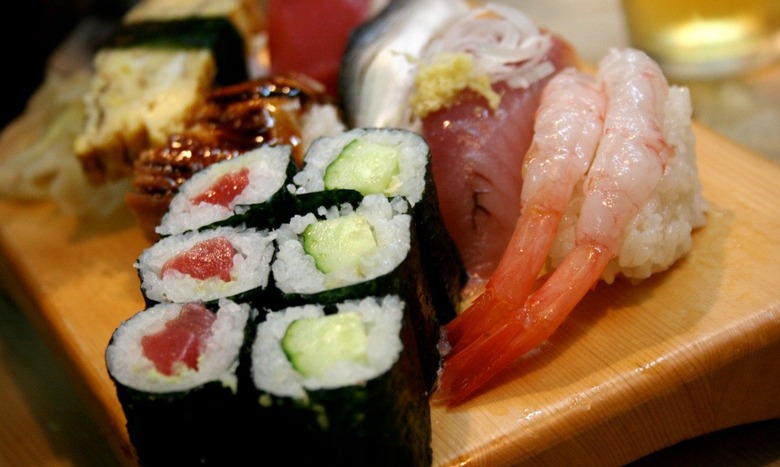Is It Safe To Eat Supermarket Sushi?
Since being introduced to the United States in 1966, American-style sushi has continued to grow in popularity. With sushi available from venues as prestigious as top-grade, Japanese-style sushi bars as well as in seemingly seedier places like convenience stores and supermarkets, it's not uncommon for sushi's quality to be called into question.
Click here to see The Best 35 Sushi Bars in America.
During its earliest years on our turf, the sushi Americans encountered was prepared in genuine Japanese fashion — modern American twists we've come to enjoy and expect like cream cheese, tempura (tempura for days... it seems as if every roll has something fried on it any more), and spicy mayo were nowhere to be found. In the 1970s, traditional Japanese sushi underwent a revolutionary change. This change, an epic Americanization of sushi inspired by the fact that tuna wasn't always available in the '70s, resulted in the crab-and-avocado roll known as the California roll.
Following the advent of the California roll, a lot of inventive, inspired American sushi rolls entered the culinary scene. Many look to sushi as an exotic meal, while many more order it for its inherent nutritional value. Often, diners request the not-so-healthy fried and cream cheese-filled options in lieu of the healthy fish, rice, and vegetable-based (avocados too, we hope) traditional rolls. Regardless, the reasoning behind one's decision to dine with chopsticks and a side of ginger (we hope you're not eating sushi with a fork, and we get that ginger shouldn't be needed on quality sushi but it just tastes so good), proof of this Japanese's popularity across the world can be seen in the environmental impact sushi love is having. Increased demand for the sushi-grade fish that many rolls require means more fishing. Over-fishing of the world's oceans is something that may mean less sushi for future generations.
It seems that the planet's health is what's at stake when it comes to supermarket sushi, not the immediate health of the consumer. Supermarket sushi tends to be refrigerated, taking away most of the risk for bacteria to accumulate. If you notice that sushi has been sitting out for a while without proper refrigeration at, say, a buffet, then you should obviously steer clear of it. Why are you going to a buffet for sushi, anyway? Otherwise, though, supermarket sushi should be a safe and nutritious food option as long as those who are preparing it are following proper food safety protocol.
Health aside, supermarket sushi's integrity should be your biggest concern. Ingredients in sushi aren't always what they seem — often, fish labeled as one thing is actually another species entirely. Wyatt Marshall of Vice's Munchies channel writes on the mislabeling of sushi:
"Fifty-eight percent of New York City sushi restaurants sold mislabeled fish in one 2012 study," Marshall says, "with as many as 13 different types of fish being passed off as 'red snapper.' The same study found that 94 percent of 'white tuna' sold wasn't white tuna at all — it was actually escolar, a type of snake mackerel (how appetizing) that has, ahem, 'purgative effects' in even small quantities."
This mislabeling of fish stems from the decades-long process of Americanizing a traditionally Japanese dish and, well, laziness. There are efforts being made to fix this, though, and plans are being put in motion to have classically trained sushi chefs in designated Japanese-grade sushi restaurants here in America and elsewhere around the world. With that being said, don't worry about the safety of your supermarket sushi — worry about the integrity of the ingredients in it and the impact that your food is having on our planet.
The accompanying slideshow is provided by fellow Daily Meal editorial staff member Dan Myers.
